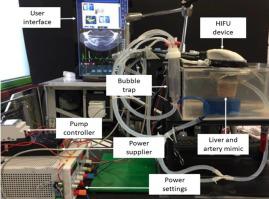IRBM ( IF 5.6 ) Pub Date : 2020-11-23 , DOI: 10.1016/j.irbm.2020.11.004 C. Cilleros , A. Dupré , J. Vincenot , D. Melodelima

|
Background
Many parameters have to be investigated before an optimal strategy for thermal therapies can be defined. Such studies are limited by the number of animals that may be included and by the difficulties in the use of isolated perfused organs. Realistic in vitro anthropomorphic vascular phantoms have been suggested and are based on the use of agar or silicone but not on biological tissues. More simply, biological and reliable models can be developed to mimic the behavior of arteries under perfusion.
Material and methods
Chicken esophagus was used since it reproduces both the anatomical and the mechanical local properties of a 5-mm-diameter artery. The esophagus was placed inside a bovine liver and connected to polyurethane tubes. The flow was driven using two pumps and a solenoid to mimic pulsed flow and the cardiac valve. The blood was mimicked using degassed water and 50-μm silica beads at a concentration of 40 mg/L. The Doppler signals used as a reference to validate the in vitro artery model were acquired during an animal study. Using a high-intensity focused ultrasound (HIFU) device, several HIFU lesions were created in vitro in liver samples with the artery mimic model placed at different depths.
Results
The waveforms of in vivo and in vitro Doppler signals had a cycle length of 1.09 s and 1.10 s, respectively, corresponding to 55 beats per minute (bpm). The average peak flow rate was 25.3 cm/s for in vivo waveforms and 27.8 cm/s for in vitro waveforms. The relative distension of the in vitro artery mimic (10%) was similar to that measured in pig mesenteric arteries and representative of human artery compliance. The dimensions of HIFU lesions were different depending on the location of the artery mimic.
Conclusions
A simple and reliable model of arteries is described. This model reproduced both the geometrical and the mechanical local properties of an artery. The flow profile, the flow rate and compliant behavior were found to be similar to those that can be recorded in vivo. This model can be used to evaluate the potential perfusion effects when developing devices for thermal therapies.
中文翻译:

建立简单的体外动脉模型并评估脉冲流对高强度聚焦超声消融的影响
背景
在定义热疗的最佳策略之前,必须研究许多参数。这样的研究受到可能包括的动物数量和使用分离的灌注器官的困难的限制。已经提出了现实的体外拟人化血管体模,其基于琼脂或硅酮的使用,但不基于生物组织。更简单地,可以开发生物学和可靠的模型来模拟灌注下的动脉行为。
材料与方法
使用鸡食道是因为它可以再现直径为5毫米的动脉的解剖结构和机械局部特性。将食道放置在牛肝内,并连接到聚氨酯管。使用两个泵和螺线管驱动流量,以模拟脉冲流和心脏瓣膜。使用脱气水和浓度为40 mg / L的50-μm硅胶珠模拟血液。在动物研究期间获取了用作验证体外动脉模型参考的多普勒信号。使用高强度聚焦超声(HIFU)设备,在体外将肝脏模拟模型放置在不同深度的情况下,在肝脏样本中创建了多个HIFU病变。
结果
体内和体外多普勒信号的波形分别具有1.09 s和1.10 s的周期长度,对应于每分钟55次搏动(bpm)。平均峰流量为25.3厘米/秒为体内波形和27.8厘米/秒为体外波形。体外动脉模拟物的相对扩张(10%)类似于在猪肠系膜动脉中测得的相对扩张,代表了人类动脉的顺应性。HIFU病变的大小因模拟动脉的位置而异。
结论
描述了一种简单而可靠的动脉模型。该模型再现了动脉的几何和机械局部特性。发现流动曲线,流速和顺应性与体内可记录的相似。当开发用于热疗法的设备时,该模型可用于评估潜在的灌注效果。











































 京公网安备 11010802027423号
京公网安备 11010802027423号